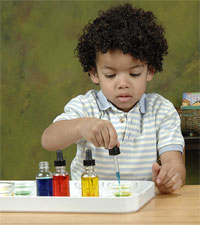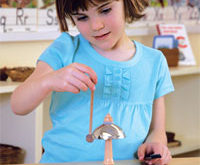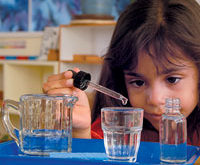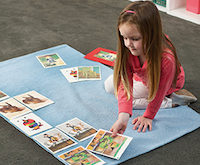 Color – the stuff of science and poetry, art and beauty. Children and adults love the magic of color, whether admiring a rainbow, watching a smoothie turn pink when strawberries are added, or just picking the perfect colored shirt to wear.
Color – the stuff of science and poetry, art and beauty. Children and adults love the magic of color, whether admiring a rainbow, watching a smoothie turn pink when strawberries are added, or just picking the perfect colored shirt to wear.
Developing the Chromatic Sense
In the primary Montessori classroom children explore color using a variety of materials. With the Metal Insets they experiment with form and color, using colored pencils to fill and shade the traced shapes. Working with the Color Boxes, children first match the color tablets of the three primary colors (red, yellow, and blue), and then move on to match secondary colors.
Later we invite children to grade the seven shades of each primary color from darkest to lightest. More challenging work includes grading two colors that are more closely related (blue and violet, for example) and finally grading all nine colors in Color Box III. Montessori was amazed by how quickly “children of three years are able to put all of the tints into gradation.” (The Montessori Method) Imagine how beautiful the original color tablets were, wound with silk thread!
Games with the Colored Tablets
Montessori wrote about observing “a game played with the greatest success and interest, and with surprising rapidity.” Three children were seated at a table. The directress put the tablets for three colors (each color having seven gradations) in mixed array. After selecting a color, each child quickly arranged his tablets from darkest to lightest. Montessori remarked on the beauty of the lines of color “giving the appearance of a strip of shaded ribbon.”
Montessori also described a memory game where the child was shown a spool of colored thread and looked at it for as long as she wished. She was then asked to find the one just a little darker (or lighter) at a distant table where all 63 spools were arranged. Montessori noted, “Children of five years enjoy this immensely, taking great pleasure in comparing the two spools and judging as to whether they have chosen correctly.” (The Montessori Method)
Color Mixing
Even toddlers can experience the magic of mixing colors by placing two different colored transparent sheets (or specially designed acrylic paddles) on top of each other to watch a third color appear. Show children how to make lighter shades of watercolors by adding tiny amounts of water. With tempura paints, ask children what they think will happen when we add white to red. Show children how to add a small amount of white, little by little, watching the color change to light red, dark pink, pale pink, etc.
Mixing colored water is a favorite activity that integrates many areas of the curriculum: science, sensorial, practical life, art, language, and even a little math (counting the drops). A simple color mixing exercise can be prepared by putting water and food coloring in eyedropper bottles to make yellow, red, and blue.
Children will see that a secondary color is made by mixing two primary colors. “I mixed red and yellow and made orange.” Most children also discover that mixing the three primary colors will make brown! Older children can experiment with making tertiary colors by mixing a primary with a secondary color.
Science, Skin Tones, and More
There are so many more wonderful activities that use color:
- Look through a prism to observe light breaking into a rainbow.
- Invite children to find objects in the environment that match a particular color tablet.
- Excuse children from circle by the colors of their clothing. “If you are wearing violet, you may go outside.”
- Introduce “skin tone” crayons. Children can match and color skin tones as they begin to explore and appreciate the diversity of the many shades of our one human race.
- Discuss the color wheel with older children, noting where the three primary colors are located. Find the secondary colors and note the pattern. (A secondary color is exactly halfway between the two primary colors it is made from.) Invite children to refer to the color wheel to make the secondary and tertiary colors. (Free color wheel charts are available on line.)
Presenting to children the color box games, color mixing, and other activities can brighten our classrooms and enhance children’s natural joy for learning and love of color.
 Montessori blog Montessori blog
Montessori blog Montessori blog 

